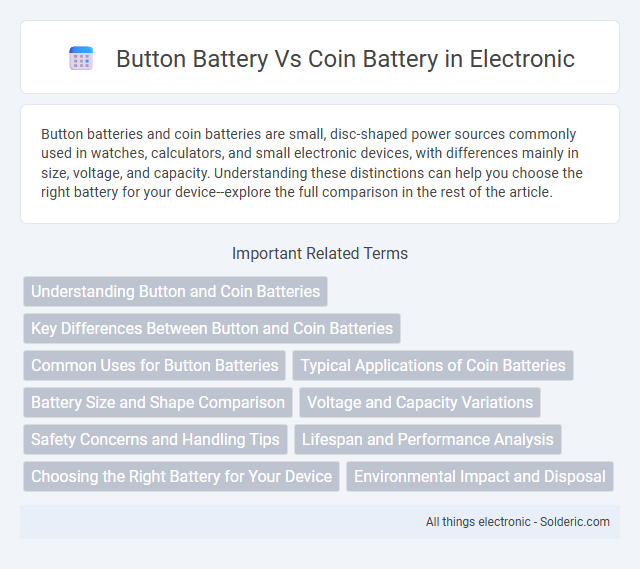Button batteries and coin batteries are small, disc-shaped power sources commonly used in watches, calculators, and small electronic devices, with differences mainly in size, voltage, and capacity. Understanding these distinctions can help you choose the right battery for your device--explore the full comparison in the rest of the article.
Comparison Table
| Feature | Button Battery | Coin Battery |
|---|---|---|
| Shape | Small, cylindrical, slightly thicker | Flat, round, thin |
| Common Sizes | LR44, SR44, A76 | CR2032, CR2025, CR2016 |
| Voltage | 1.5V to 3V | Typically 3V |
| Typical Uses | Calculators, watches, toys | Watches, key fobs, small electronics |
| Capacity | Lower mAh range | Higher mAh range |
| Design Focus | Compact power source with thickness | Thin profile for slim devices |
Understanding Button and Coin Batteries
Button batteries and coin batteries are small, round power sources commonly used in devices like watches, calculators, hearing aids, and small electronics. Button batteries are typically smaller and thinner with a variety of chemistries such as alkaline, silver oxide, and lithium, whereas coin batteries are slightly larger and often have higher capacity, primarily using lithium technology for longer-lasting power. Understanding the differences in size, chemical composition, and energy capacity helps in selecting the appropriate battery type for specific device requirements and safety considerations.
Key Differences Between Button and Coin Batteries
Button batteries are small, disc-shaped power sources primarily used in hearing aids, watches, and small electronic devices, while coin batteries are slightly larger and commonly found in calculators, key fobs, and remote controls. Key differences include size, voltage range, and capacity, with coin batteries generally offering higher capacity and longer life due to their larger size. Your choice between button and coin batteries should consider device requirements, voltage needs, and expected battery life for optimal performance.
Common Uses for Button Batteries
Button batteries are commonly used in small electronic devices such as watches, hearing aids, and calculators due to their compact size and steady power output. These batteries provide reliable energy for medical devices like glucose monitors, ensuring consistent performance. Your choice of button battery depends on the device's power requirements and size constraints.
Typical Applications of Coin Batteries
Coin batteries are commonly used in small electronic devices such as watches, hearing aids, calculators, and key fobs due to their compact size and reliable power output. Their shape and voltage make them ideal for low-drain applications requiring a long-lasting energy source. You will often find coin batteries in devices where space is limited but consistent power is essential.
Battery Size and Shape Comparison
Button batteries are typically small, cylindrical cells with a diameter ranging from 5 to 25 millimeters and a thickness of 1 to 6 millimeters, designed for compact electronic devices. Coin batteries, also known as coin cells, have a flat, round shape resembling a coin, commonly measuring between 5 to 30 millimeters in diameter and 1 to 6 millimeters in thickness, offering a larger surface area for stable voltage output. Both battery types vary in size and capacity, but coin batteries generally provide higher energy density due to their wider diameter and flat design.
Voltage and Capacity Variations
Button batteries typically range from 1.2 to 3 volts, with capacities between 20mAh and 200mAh depending on the chemistry, whereas coin batteries usually offer voltages around 3 volts and capacities from 30mAh to 250mAh. Lithium coin cells, such as the CR2032, deliver higher energy density and longer shelf life compared to silver oxide button cells, which provide more stable voltage output but lower capacity. Voltage stability and battery capacity are crucial factors influencing the choice between button and coin batteries for devices requiring consistent power over time.
Safety Concerns and Handling Tips
Button batteries and coin batteries pose significant safety concerns, especially for children, as they can cause severe internal burns if swallowed due to their chemical composition and electrical current. Proper handling includes keeping these batteries out of reach, securely sealing battery compartments in devices, and immediately seeking medical help if ingestion is suspected. You should also store batteries in their original packaging or a secure container to prevent accidental swallowing or short-circuiting.
Lifespan and Performance Analysis
Button batteries typically offer shorter lifespans ranging from 1 to 3 years, depending on the device power demand and battery chemistry, while coin batteries can last up to 5 years due to larger capacity and enhanced energy density. Performance analysis indicates that coin batteries deliver more stable voltage output and higher capacity, making them ideal for devices requiring consistent power like medical implants and watches. Both battery types use similar lithium or alkaline chemistries, but coin batteries generally outperform button batteries in longevity and sustained energy delivery.
Choosing the Right Battery for Your Device
Button batteries and coin batteries both serve as compact power sources, but their size and voltage differ, influencing device compatibility; coin batteries are generally larger and offer higher capacity, suitable for devices requiring longer battery life. Button batteries fit smaller electronics like hearing aids or watches, providing adequate power without adding bulk. Your choice depends on device specifications, power needs, and physical space constraints to ensure optimal performance and safety.
Environmental Impact and Disposal
Button batteries and coin batteries both contain heavy metals like mercury, cadmium, and lead, posing significant environmental hazards if improperly disposed. Their small size often leads to accidental disposal in household trash, increasing the risk of soil and water contamination due to leaching of toxic substances. Proper recycling protocols through designated hazardous waste programs are essential to mitigate environmental impact and prevent toxic release into ecosystems.
Button battery vs Coin battery Infographic

 solderic.com
solderic.com